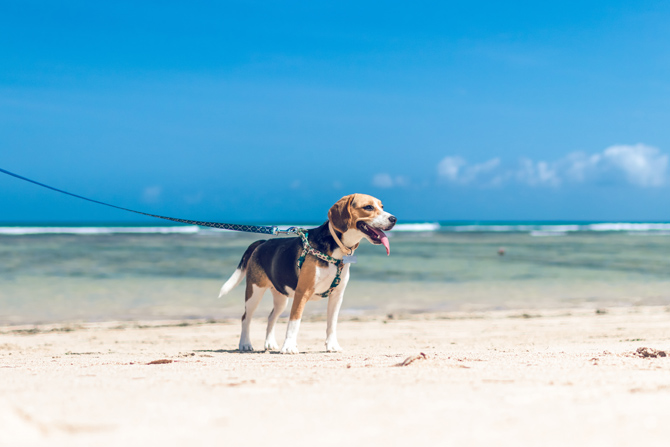While the summer months bring long hot days, beautiful sunshine and blue skies, it’s essential to protect your dog’s paws during hotter months.
Sure, your fur baby might like ocean swims just as much as you do, but I bet he doesn’t like suffering burns to his paw pads! Sadly, many owners forget their barking buddy’s paw pads can easily get burnt.
Indeed, how many times have you had to hotfoot it up from the beach because the sand is scalding hot and you forgot to bring your thongs? Likewise, have you ever been caught out dashing to the shops barefoot, only to step out of your vehicle and discover the car park floor feels like molten lava on the soles of your feet?
Well, it’s important to remember our fur pals don’t have the luxury of popping on a pair of shoes, as we humans do. As such, you need to take action to protect your dog’s paws.
Tips to protect your dog’s paws this beach season
With summer well underway, it’s time to pay attention to your fur baby’s paws. Certainly, paw pads are pretty clever. They are intended to absorb shock and reduce the pressure put on your dog’s joints and bones.
The special skin on the pad not only helps your dog recognise the different types of surface he’s walking on, but also protects the paws. However, just like shoes, there is only so much protection a dog’s paw pads can provide.
During summer pavements and sand don’t just get hot; they can get EXTREMELY hot. So hot in fact, they can inflict third-degree burns. Signs your dog may have sustained an injury or burns to his paw pads include:
- Limping
- Refusing to walk
- Chewing or licking his paws
- Yelping
- Blisters or redness
Preventing paw pad burns
Being a ‘paw-fect’ pet owner means taking as many precautionary measures as you can to help prevent paw pad burns. Here are some simple ways to protect your dog’s paws this summer.
Avoid walking your dog during the heat of the day (generally 12-2 pm). Instead, stick to walking early in the morning or later on in the evening. It’ll be much more pleasant for you too!
If possible, avoid walking your dog on the sand or pavement. Did you know sand can reach temperatures of 130-140 degrees during the heat of the day? Instead encourage your dog to walk on the grass, as this will help protect your dog’s paws from pad burns.
Maintain the health of your dog’s paws. Check your pooch’s paws regularly for cuts, burns, cracking and peeling skin. You can help keep your dog’s paws moisturised with a specially formulated paw balm. Alternatively, you can use Vaseline.
Super concerned about protecting your dog’s paws? You might want to consider buying dog shoes. No, really! Dog shoes are specifically designed to protect your dog’s paws and keep them dry. Just remember, dogs perspire through their paws (as well as their mouth, of course!), so our furry friends shouldn’t wear shoes for prolonged periods of time—only while out walking.
Treating paw pad burns
How you treat your dog’s paw pad burns really depends on how badly the paws are affected. If you feel the burn is severe or is causing your dog major discomfort, you should seek advice from your local vet.
A vet may prescribe antibiotics, particularly if the paw pad is cracked or injured, to help prevent infection. Some form of pain relief may also be necessary to alleviate any discomfort your fur pal may be experiencing.
In cases of mild burns, you can immerse the dog’s paw in cool water, or hold it under cool running water for several minutes. Apply an antibiotic cream to the paw pad to help reduce the likelihood of infection and bandage the foot to stop the dog from licking it. Monitor the paw daily and repeat the previous steps. If the paws become worse, get in touch with your vet.
Has your dog ever suffered from paw pad burns?
Information sources:
Buzhardt, L. First aid for torn or injured food pads in dogs. Accessed online via: https://vcahospitals.com/







Leave A Comment